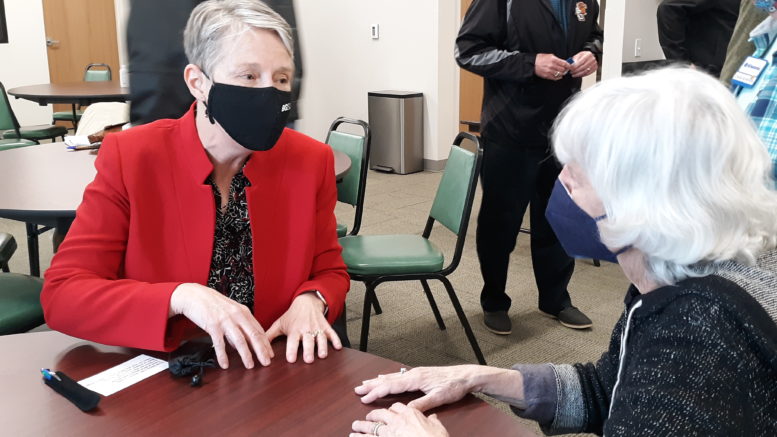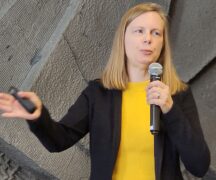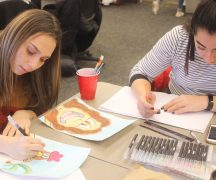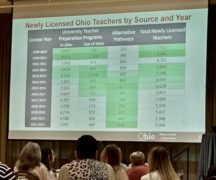By JAN LARSON McLAUGHLIN
BG Independent News
Students are struggling to make up for lost learning during COVID. And teachers are being asked to meet demands that are almost impossible under ideal conditions.
“We need better teachers than we’ve ever needed before,” said Dr. Dawn Shinew, dean of the BGSU College of Education and Human Development.
But too few people now want to become teachers, and too many educators are exhausted and want out after being asked to completely change the way they taught over the last two years.
Shinew – a third generation educator – talked about “Preparing Tomorrow’s Teachers in Challenging Times” Thursday to the Bowling Green Kiwanis Club.
It was nearly two years ago when schools had to completely revamp how they educated students.
“Our world, in the course of a week, turned upside down,” Shinew said.
The effects of those changes are now documented:
- Third grade students learned roughly 20 percent less in English Language Arts on average between November 2020 and April 2021 as compared to students in prior years.
- Declines were larger for lower-achieving, economically disadvantaged, and minority student subgroups and among districts that spent the majority of the year in fully remote instruction.
- In grades 5-8, declines are roughly equivalent to between one-half and a whole year’s worth of learning in math and between one-third and one-half a year’s worth of learning in English Language Arts, depending on the grade.
- Compared to their peers, historically underserved student subgroups (measured by race, income, homelessness, disability, and English-learner status) generally experienced test score declines that were 1.5-2 times larger in English Language Arts compared to their peers.
In some cases, students were trying to do their homework on their cellphones, with limited data plans, Shinew said.
“In K-12, we have problems,” she said. “None of us could have anticipated the impact this would have. It was unimaginable that our teachers would be asked to do this.”
Now teachers are charged with playing catch up with kids who have fallen behind. BGSU is partnering with schools, businesses and agencies to help, Shinew said.
“We have a responsibility to do something about this,” she said of the loss in learning. “We need to think about doing more.”
Academic Enrichment Camps for grades 3-8 are being offered in the summer – with 600 attending last summer and a goal of 1,000 for this summer. Teacher candidates are tutoring small groups of students.
“We need to be outside the box. We need to be innovative,” Shinew said.
Meanwhile, the nation is facing an unprecedented teacher shortage
A 2019 analysis from the Center for American Progress reports that enrollment in teacher preparation programs has declined by 35% nationally and by 47% in the state of Ohio.
BGSU’s teacher education program is down about 4%, Shinew said.
“We alone are not going to be able to change the trajectory of the state of Ohio,” she said.
Shinew said she recently talked with a superintendent whose district is trying to fill a second grade position.
“There was a time he would have had hundreds of applications for a second grade position – and he had four,” she said.
At the same time fewer people want to go into teaching, more people want to get out of the profession.
In 2022, Ohio’s State Teacher Retirement System is projecting almost twice the number of retirements (approximately 5,200) as the number of new teachers licensed (about 2,700) in the state.
“Many are saying, ‘I can’t do this anymore,’” Shinew said. “It’s not just the pandemic. It is a difficult, difficult time to be in education.” There is a lack of respect for the education system, with parents screaming at school board meetings, she said.
Some school districts in the state are having to close occasionally because there aren’t enough teachers to staff classrooms.
“What’s going to happen when there are no teachers in the classroom?” she said. “This is unimaginable.”
Critical shortage areas right now are:
- Substitute teachers. In response to the crisis, the Ohio Legislature temporarily reduced the minimum requirement to a high school degree.
- High school math and science teachers.
- Special education teachers.
- School psychologists.
Schools and universities that produce teachers have to get creative to solve this problem, Shinew said.
“It is a national crisis,” she said.
Meanwhile, proposed state legislation such as a bill requiring teachers to post their lesson plans online a year in advance, is just making an already tough job even less attractive to education prospects.
The answer has to get beyond “we can’t possibly make this work?” to “how can we possibly make this work?” Shinew said.
BGSU is offering an alternative resident educator program that does the following:
- Partners with more than 30 PK-12 districts and community agencies (YMCA, Big Brothers/Big Sisters) throughout Northwest Ohio to recruit and hire 100 new teachers for alternative licensure to fill high-demand positions.
- Designed for individuals with extensive life and professional experiences interested in teaching.
- Provides opportunities to earn regular teacher salary while meeting licensure requirements through BGSU.
“This takes people with life experiences and gets them in classrooms,” Shinew said.
Other possibilities are being floated with the state legislature and Ohio Department of Education, such as:
- Loan forgiveness programs.
- Increased state tax credits for educators.
- Streamlined pathways into Educator Preparation Programs through College Credit Plus and Community College Articulation Agreements.
- Recruitment and retention plans for teachers from under-represented minority groups.
- Campaigns to improve working conditions for teachers.
“It’s not about pay,” though pay for beginning teachers in Ohio is abysmal, Shinew said. The average Ohio teacher’s annual salary is $70,000, she said. “It’s about quality of life and flexible work schedules.”
“I can’t imagine a more important service. We need them more than ever,” she said of teachers. “We’re all in this together. We owe it to them to be flexible.”





